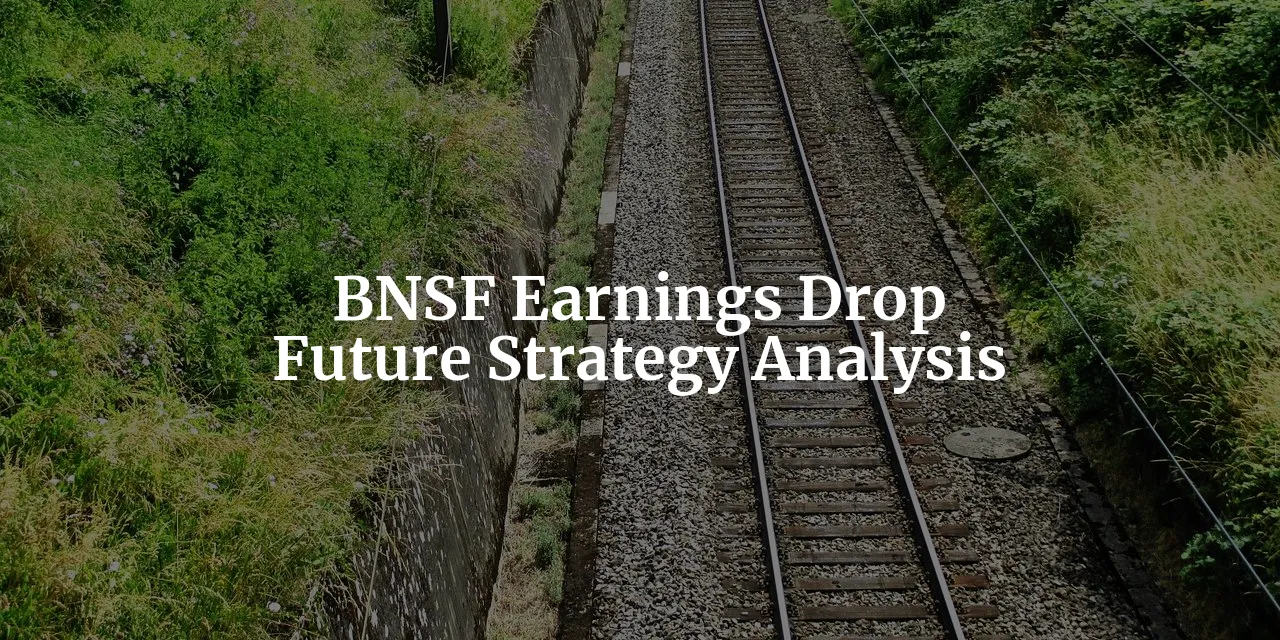Tags: BNSF / Earnings
This fanpage is not officially affiliated with Berkshire Hathaway: Disclaimer
Based on Berkshire Hathaway's annual report, let us dive into a comprehensive analysis of BNSF's declined earnings in 2023, exploring historical trends, economic context, and strategic responses.

Introduction
Burlington Northern Santa Fe, LLC (BNSF), a cornerstone in Berkshire Hathaway's diverse portfolio, has long been heralded as a bellwether for the U.S. economy due to its extensive freight operations crisscrossing the nation. Historically, BNSF's financial performance has not only reflected the broader economic climate but also significantly contributed to Berkshire Hathaway's prosperity. However, the Annual Report 2023 reveals a concerning downturn, with BNSF's earnings experiencing a notable decline 12.
The year 2023 presented a maelstrom of challenges for the railroad industry, compounded by broader economic headwinds affecting the transportation sector at large. Amidst these adversities, BNSF's earnings dip emerges as a critical point of concern for stakeholders and warrants a thorough examination. This article aims to dissect the layers behind this financial setback, exploring its implications for shareholders and envisaging the company's trajectory in the face of evolving economic landscapes.
Understanding the multifaceted aspects of BNSF's operations and financial health is imperative. This analysis will delve into historical, political, and economic insights to paint a comprehensive picture of the situation at hand. For Berkshire Hathaway shareholders, grasping the nuances of BNSF's current predicament and future outlook is essential. Thus, this article is structured to provide a deep dive into BNSF's 2023 performance, juxtaposed with its historical achievements and the broader economic and industrial backdrop, leading to a discussion on strategic responses and implications for shareholders.
BNSF's Performance in 2023: A Closer Look
The Annual Report 2023 delineates a year of financial contraction for BNSF, marking a significant departure from its previous growth trajectory. A detailed analysis of the financial metrics provides insight into the various factors contributing to this downturn 12.
Pre-tax earnings plummeted by 14.2% in 2023 compared to the preceding year, a stark indicator of the financial hurdles faced by the company. This decline in earnings is mirrored by a 6.9% decrease in railroad operating revenues, underscoring the challenges in maintaining revenue streams amidst economic volatility. Specifically, revenues from consumer products saw a dramatic reduction of 14.7%, signaling a significant shift in consumer demand and supply chain dynamics. Conversely, industrial products presented a silver lining, with a modest increase of 1.8% in operating revenues, suggesting some resilience in this segment. However, agricultural products and coal did not fare as well, with decreases of 2.8% and 3.4%, respectively, further contributing to the revenue slump 1.
A notable aspect of the financial report is the decline in fuel expenses by 19.6%, a consequence of fluctuating oil prices and perhaps more efficient fuel management strategies. However, this reduction in expenses was offset by a 4.7% increase in compensation and benefits expenses, reflecting the growing cost pressures from labor demands 1.
Interestingly, other revenues (expenses), net saw a significant increase of 90%, a figure that may hint at strategic financial maneuvers or one-off gains that partially cushioned the impact of declining operational revenues. Yet, despite these cost adjustments and strategic financial management, the overall net earnings saw a downturn from $5,946 million in 2022 to $5,087 million in 2023, emphasizing the gravity of the financial challenges faced 2 ↗.
Here's an overview of BNSF's 2023 financial results compared to the two previous years - dollars in million 2:
| Revenues / Expenses | 2023 | 2022 | 2021 |
|---|---|---|---|
| Railroad operating revenues | $23,474 | $25,203 | $22,513 |
| Railroad operating expenses | |||
| Compensation and benefits | $5,500 | $5,253 | $4,696 |
| Fuel | $3,684 | $4,581 | $2,766 |
| Purchased services | $2,049 | $2,102 | $2,033 |
| Depreciation and amortization | $2,617 | $2,517 | $2,444 |
| Equipment rents, materials and other | $2,209 | $2,147 | $1,763 |
| Total railroad operating expenses | $16,059 | $16,600 | $13,702 |
| Railroad operating earnings | $7,415 | $8,603 | $8,811 |
| Interest expense | ($1,048) | ($1,025) | ($1,032) |
| Other revenues (expenses), net | $247 | $130 | $82 |
| Pre-tax earnings | $6,614 | $7,708 | $7,861 |
| Income taxes | $1,527 | $1,762 | $1,871 |
| Net earnings | $5,087 | $5,946 | $5,990 |
The comparison with the previous year's performance accentuates the contrast even more starkly. The year 2022 was marked by an 11.9% increase in railroad operating revenues compared to 2021, with significant growth across all major revenue segments. This juxtaposition underscores the volatility and unpredictability of the market, further complicating the outlook for BNSF 1.
Moreover, the decline in earnings per car/unit by 5 cents not only reflects the immediate financial implications but also raises concerns about operational efficiency and the capacity to optimize revenue generation amidst fluctuating demand and operational challenges 1.
BNSF's performance in 2023 paints a picture of a company navigating through a tumultuous economic landscape, grappling with both internal cost pressures and external market forces. The detailed financial metrics reveal a nuanced story of resilience in certain segments, overshadowed by broader challenges that have led to a significant earnings decline ↗. As we proceed, the analysis will explore the historical performance trends, the broader economic and industrial landscape, and BNSF's strategic responses to these challenges, aiming to provide shareholders with a clear understanding of the path forward.
Historical Performance and Trends
Over the past decade, BNSF Railway has experienced a rollercoaster of earnings and performance fluctuations, reflective of the broader economic and industrial landscapes in which it operates. As a pivotal player in the transportation sector, BNSF's journey through periods of economic recessions, political decisions, and global events offers a compelling narrative on resilience and strategic adaptation.
The decline in BNSF's earnings in 2023, with traffic slumping by 5.7% and specific sectors like grain and intermodal traffic experiencing declines of 12% and 9.5% respectively, marks a significant event in the company's recent history 4. However, this is not the first time BNSF has faced challenges. Comparing this downturn to historical fluctuations reveals a pattern of resilience and strategic recalibration. For instance, the fourth-quarter volume increase of 4.1% in 2023 suggests a potential rebound, reminiscent of past recoveries 4.
The railroad industry, particularly Class I railroads, has navigated growth and challenges, influenced by external factors such as economic shifts and global trade dynamics. BNSF's strategic initiatives and investments have been central to its ability to weather these storms ↗. The announcement of a $3.92 billion capital investment plan for 2024, focusing on core network maintenance, equipment acquisitions, and expansion projects, underscores BNSF's commitment to growth and adaptation 7. This mirrors past investments that have bolstered the company's resilience and competitive edge.
The adoption of Precision Scheduled Railroading (PSR) has significantly impacted the industry, aiming to enhance efficiency and reduce operational costs. While PSR has led to increased free cash flow (FCF), it has not been the primary driver behind greater shareholder returns 5. BNSF's strategic decision to maintain a steady Debt to Equity (D/E) ratio, in contrast to other Class 1 railroads that have seen their D/E ratios steadily increase since 2017, positions BNSF favorably in terms of financial health and stability 5.
The Broader Economic and Industrial Landscape
The economic conditions of 2023, characterized by rising inflation rates, have exerted considerable pressure on transportation costs and consumer behavior. Inflation's rapid rise outpaced Class 1 railroads' ability to reprice their business, impacting earnings and operational costs 5. The transportation sector, and the railroad industry in particular, has faced volume declines and challenges, with overall U.S. rail traffic down by 2.3% and intermodal volume decreasing by 4.9% compared to 2022 4.
The competitive landscape within the railroad industry has been equally challenging, with Canadian Pacific Kansas City emerging as the only Class I railroad to report higher volume in 2023 4. This underscores the intense competition and the need for strategic differentiation in the industry.
Government policies, deficit spending, and entitlement spending have further complicated the economic landscape for the transportation sector ↗. Deficit spending during economic downturns aims to mitigate reduced economic activity's impact, but it also poses challenges in managing debt and funding infrastructure investments 5. The transportation sector, reliant on robust infrastructure, is directly affected by these policies and spending priorities.
Global trade dynamics have played a crucial role in shaping freight volumes, particularly in sectors like agricultural products, consumer goods, and industrial products. The decline in grain and intermodal traffic for BNSF in 2023 reflects broader trends in global trade and economic activity 4. Additionally, the long-term impacts of climate change and environmental policies loom large over the railroad industry, necessitating strategic responses to ensure sustainability and compliance. As a positive note, U.S. rail traffic ended 2023 on a high note with the best quarter in terms of volumes on a year-over-year basis 6.
Technological advancements offer a beacon of hope for the railroad industry, promising efficiency improvements and potential automation. The adoption of these technologies could redefine operational models and competitive strategies in the years to come.
In navigating the broader economic and industrial landscape, BNSF and its peers in the railroad industry face a complex web of challenges and opportunities. Strategic investments, technological adoption, and adaptive strategies will be pivotal in charting a course through these turbulent waters.
BNSF's Strategic Response and Future Investments
In response to the challenges faced in 2023, BNSF Railway has unveiled a robust 2024 capital investment plan totaling $3.92 billion. This strategic allocation is aimed at reinforcing the core network and assets with a substantial $2.88 billion, while setting aside $440 million for equipment acquisitions and nearly $600 million dedicated to expansion and efficiency projects 7 ↗↗. Such a significant investment underscores BNSF's commitment to not only maintaining but also enhancing its operational capabilities and service offerings.
The strategic importance of the planned projects cannot be overstated. New track construction in Eastern Kansas, terminal improvements in New Mexico, and facility expansion in Chicago are pivotal. These initiatives are designed to address the bottlenecks and inefficiencies that have hampered BNSF's performance, positioning the company for future growth. Moreover, these projects reflect a broader strategy to enhance connectivity and capacity across the network, facilitating smoother and more efficient cargo movement.
Innovation and technology play critical roles in BNSF's strategic vision. By incorporating advanced technologies, BNSF aims to improve operational efficiency and customer service, thereby strengthening its competitive edge in the logistics and transportation industry. The focus on innovation is expected to yield significant improvements in safety, reliability, and overall performance.
Furthermore, BNSF's commitment to diversity and inclusion, as recognized by Newsweek's ranking of "America's Greatest Workplaces for Diversity 2024," plays a vital role in its strategic response 8. This accolade not only highlights BNSF's dedication to fostering an inclusive culture but also enhances its appeal as an employer of choice. By attracting and retaining top talent, BNSF is better positioned to tackle the challenges ahead and drive sustained growth.
The potential impact of these investments and strategies on BNSF's financial performance and market position is substantial. By addressing current challenges and investing in future growth, BNSF is laying the groundwork for improved profitability and market share. Furthermore, the alignment of BNSF's strategic choices with future trends in the railroad industry, such as sustainability and digitalization, ensures the company's relevance and competitiveness in the years to come.
Shareholder Implications
The decline in BNSF's earnings in 2023 undoubtedly has immediate implications for Berkshire Hathaway shareholders. In the short term, this performance dip may cause concern among investors, potentially affecting Berkshire Hathaway's stock price and investor sentiment. However, it is essential to consider the long-term impacts on shareholder value, particularly in light of BNSF's strategic investments and the broader economic context.
BNSF's comprehensive capital investment plan for 2024 is a clear indication of the company's commitment to overcoming current challenges and driving future growth. For Berkshire Hathaway shareholders, this strategic approach is reassuring, as it aligns with Warren Buffett's investment philosophy of value investing and long-term growth. By focusing on strengthening its core assets and expanding its network, BNSF is positioning itself for sustained profitability, which is expected to contribute positively to shareholder value over time.
Moreover, BNSF's performance and strategic direction play a crucial role within Berkshire Hathaway's diversified portfolio. As one of the conglomerate's significant subsidiaries, BNSF's success is integral to Berkshire Hathaway's overall financial health and investment strategy. Therefore, the company's ability to navigate challenges and capitalize on growth opportunities is paramount for maintaining shareholder trust and confidence.
Transparency, communication, and management's proactive response to challenges are essential for preserving shareholder trust. In this context, BNSF's clear articulation of its strategic investments and future plans is vital. Additionally, the potential for dividends, stock buybacks, or other shareholder returns, as part of BNSF's strategy moving forward, could further enhance shareholder value and sentiment.
While BNSF's earnings decline in 2023 presents immediate challenges, the company's strategic response and future investments offer a promising path to recovery and growth ↗. For Berkshire Hathaway shareholders, understanding the long-term implications of these strategies, in line with Warren Buffett's investment philosophy, is crucial for informed investment decisions. As BNSF continues to adapt and evolve, its role within Berkshire Hathaway's portfolio remains a key factor in the conglomerate's success and resilience in the face of economic fluctuations.
Or, as Warren Buffett put it in this year's Chairman's Letter 1:
I am particularly proud of both BNSF’s contribution to the country and the people who work in sub-zero outdoor jobs in North Dakota and Montana winters to keep America’s commercial arteries open. Railroads don’t get much attention when they are working but, were they unavailable, the void would be noticed immediately throughout America. A century from now, BNSF will continue to be a major asset of the country and of Berkshire. You can count on that.

Conclusion
The analysis of BNSF's 2023 earnings decline sheds light on the challenges faced by the company amidst a turbulent economic landscape. The financial metrics reveal a significant downturn in pre-tax earnings, operating revenues, and earnings per car/unit, reflecting the impact of external market forces and internal cost pressures. However, when viewed in the context of historical performance trends, BNSF's resilience and strategic adaptability come to the fore, showcasing a track record of overcoming challenges and driving growth.
The broader economic and industrial landscape presents a complex web of challenges, including rising inflation rates, global trade dynamics, and technological advancements. BNSF's strategic response, characterized by a substantial 2024 capital investment plan focusing on core network maintenance, equipment acquisitions, and expansion projects, demonstrates the company's commitment to enhancing operational capabilities and service offerings. Additionally, BNSF's emphasis on innovation, diversity, and inclusion aligns with future industry trends and positions the company for sustained success.
For Berkshire Hathaway shareholders, the implications of BNSF's performance downturn in 2023 are significant but should be viewed within the broader context of the company's strategic investments and long-term growth prospects. Transparency, communication, and management's proactive response to challenges are crucial for maintaining shareholder trust and confidence. As BNSF continues to navigate challenges and capitalize on growth opportunities, shareholders are encouraged to stay informed, engaged, and supportive of the company's strategic direction.
In conclusion, BNSF's ability to adapt, invest in infrastructure and technology, and leverage its historical resilience bodes well for its future prospects. With Berkshire Hathaway's support and strategic vision, BNSF is poised to overcome current challenges and drive sustained growth in the years to come.
References
-
Annual Report 2023 - Management’s Discussion and Analysis - Railroad - www.berkshirehathaway.com ↩↩↩↩↩↩↩
-
Annual Report 2023 - Management’s Discussion and Analysis - Railroad income summary table - www.berkshirehathaway.com ↩↩↩↩
-
Annual Report 2023 - Railroad Business — Burlington Northern Santa Fe - www.berkshirehathaway.com ↩
-
Five of the six Class I railroads see volume declines in 2023 - Trains - www.trains.com ↩↩↩↩↩
-
Is the Rail Industry Past its Peak? - www.linkedin.com ↩↩↩↩
-
For U.S. Rail Traffic, 2023 Ends on a High Note - Railway Age - www.railwayage.com ↩
-
BNSF announces plan for 2024 capital investments - www.bnsf.com ↩↩
-
BNSF Railway ranks among America’s Greatest Workplaces for Diversity - www.bnsf.com ↩












